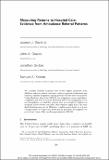Measuring Returns to Hospital Care: Evidence from Ambulance Referral Patterns
Author(s)
Graves, John A.; Kleiner, Samuel A.; Doyle, Joseph J; Gruber, Jonathan
DownloadGraves_Measuring returns.pdf (745.8Kb)
PUBLISHER_POLICY
Publisher Policy
Article is made available in accordance with the publisher's policy and may be subject to US copyright law. Please refer to the publisher's site for terms of use.
Terms of use
Metadata
Show full item recordAbstract
We consider whether hospitals that receive higher payments from Medicare improve patient outcomes, using exogenous variation in ambulance company assignment among patients who live near one another. Using Medicare data from 2002–10 on assignment across ambulance companies and New York State data from 2000–6 on assignment across area boundaries, we find that patients who are brought to higher-cost hospitals achieve better outcomes. Our estimates imply that a one standard deviation increase in Medicare reimbursement leads to a 4 percentage point (or 10 percent) reduction in mortality; the implied cost per at least 1 year of life saved is approximately $80,000.
Date issued
2015-02Department
Massachusetts Institute of Technology. Department of Economics; Sloan School of ManagementJournal
Journal of Political Economy
Publisher
University of Chicago Press
Citation
Doyle, Joseph J., John A. Graves, Jonathan Gruber, and Samuel A. Kleiner. “Measuring Returns to Hospital Care: Evidence from Ambulance Referral Patterns.” Journal of Political Economy 123, no. 1 (February 2015): 170–214. © 2015 The University of Chicago
Version: Final published version
ISSN
0022-3808
1537-534X